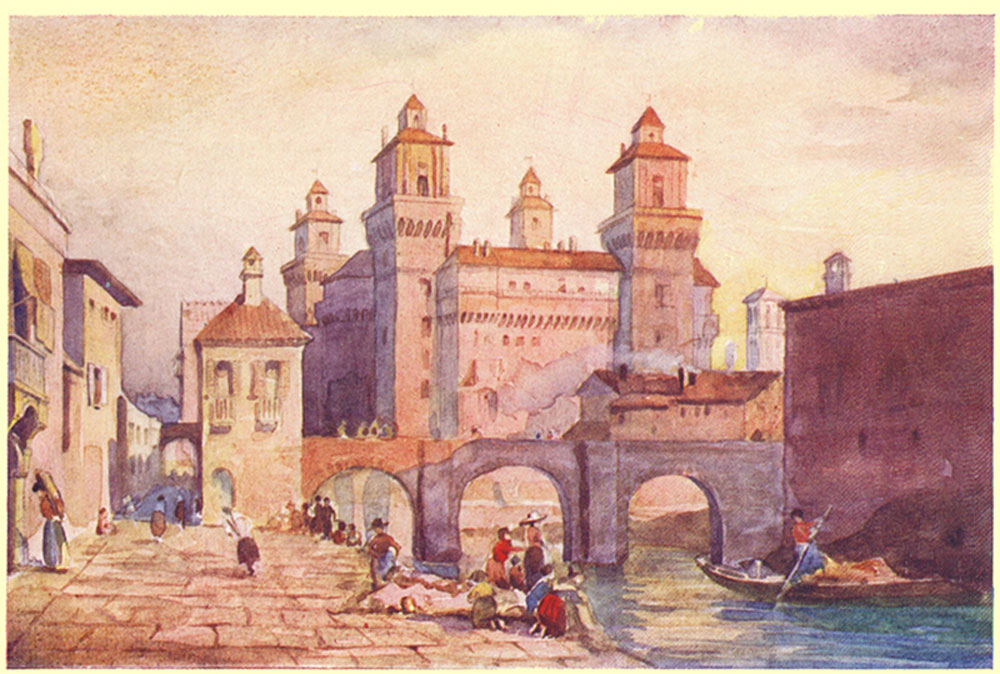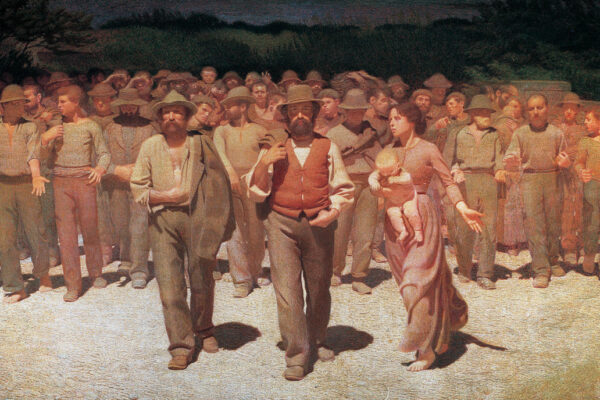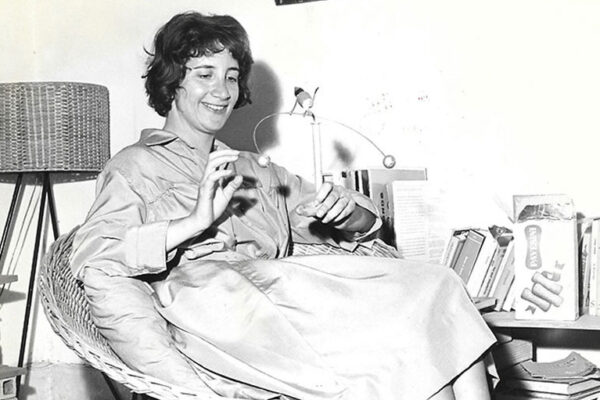Courtesy of Judaism: A Quarterly Journal of Jewish Life and Thought, June 2004
Giorgio Bassani’s Ferrara may be, as an American critic has called it, a “semiotic labyrinth,” but it is no doubt a very faithful representation of this city, of its history and topography. Actually, the success of his works, especially of his Giardino dei Finzi Contini (The Garden of the Finzi Continis), a novel that remained for years at the top of the best-sellers list, and in this country the even bigger success of the Oscar winning movie adapted from that novel and directed by Vittorio De Sica–a movie Bassani was never happy with–did succeed in putting Ferrara on the map for thousands of international tourists, who happily flocked to Ferrara in order to look at the city’s medieval walls, the Ghetto district, the wonderful seventeenth-century Jewish cemetery, but often regretted not finding, much to their disappointment, the luscious garden of the title, that Bassani had mentally transported there from Rome. It was based, as the hapless tourists did not know, on the garden of the Palazzo Torlonia.
 Apart from that, even if Ferrara was still an anonymous citta di provincia, a provincial town, in the first collection of stories that Bassani published in 1940 under an assumed Catholic surname, and was to remain unidentified, or just identified with a capital F followed by a dot, until the 1956 award winning edition of what was finally called Cinque Storie Ferraresi, his work has been justly defined by Andre Sempoux as “a monument of urban psychosociology.” Its streets, houses, restaurants, clubs, theateres, etc., are just named, just quoted, never described, as a non-citizen would have to do. This holds, no doubt, for the Ferrara he lived in, after his birth in nearby Bologna, from his childhood to the Forties, when after being arrested and detained some time in jail by the Fascist police he managed, after the alas temporary fall of Fascism in July 1943, to move to Naples and later to Rome, which became his favorite city even if he often came back to Ferrara, to visit his mother and the family home. But even the older Ferrara, the Ferrara of a distant past, which he obviously hadn’t seen, could easily be reconstructed and revisited, as in the opening lines of such Ferrarese stories as La passeggiata prima di cena (A Walk Before Dinner) or Gli occhiali d’ oro (The Gold-Rimmed Spectacles).
Apart from that, even if Ferrara was still an anonymous citta di provincia, a provincial town, in the first collection of stories that Bassani published in 1940 under an assumed Catholic surname, and was to remain unidentified, or just identified with a capital F followed by a dot, until the 1956 award winning edition of what was finally called Cinque Storie Ferraresi, his work has been justly defined by Andre Sempoux as “a monument of urban psychosociology.” Its streets, houses, restaurants, clubs, theateres, etc., are just named, just quoted, never described, as a non-citizen would have to do. This holds, no doubt, for the Ferrara he lived in, after his birth in nearby Bologna, from his childhood to the Forties, when after being arrested and detained some time in jail by the Fascist police he managed, after the alas temporary fall of Fascism in July 1943, to move to Naples and later to Rome, which became his favorite city even if he often came back to Ferrara, to visit his mother and the family home. But even the older Ferrara, the Ferrara of a distant past, which he obviously hadn’t seen, could easily be reconstructed and revisited, as in the opening lines of such Ferrarese stories as La passeggiata prima di cena (A Walk Before Dinner) or Gli occhiali d’ oro (The Gold-Rimmed Spectacles).
All the narrator needs is looking at an old picture postcard, that soon became alive and teeming with real people, using as an introduction a sort of verbal flashback that may remind us of the many indifferent screenplays Bassani did write or contributed to, always claiming that they were just business to him and that he could never remember a single page of the perhaps two or three thousand he had written for various Italian film directors. So consider the following passage from Giorgio Basssani:
Time has begun to thin their ranks, but still you cannot say they
are few, the people in Ferrara who remember Doctor Fadigati (…)
It was in 1919, just after the other war. Because of my age, I
myself can give only a rather vague, confused picture of the
period. The cafes swarmed with officers still in uniform (…),
trucks went by constantly with flags flapping; on the scaffolding
that covered the facade of the Insurance building then under
construction an enormous scarlet banner … invited friends and
enemies of socialism to drink in harmony the Lenin aperitif. (Bill
Weaver’s translation) (1)
Athos Fadigati, the ear nose and throat specialist who is the protagonist of this excellent novella is one of the few Bassani characters who is not Jewish and not a Ferrarese, having moved there from nearby Veneto. But what happens to him towards the end of the Thirties–a sudden ostracism, the complete banishment from Ferrara society, a sort of cancellation, because of a scandal deriving from what we would today politely call his sexual orientation–is similar to what happens to the Jewish Ferrarese narrator of the story. He is a student in his early 20s who obviously is one of the first autobiographical representations of the author (within the process that Marilyn Schneider calls self-inscription), soon to be followed by the world-wide success of the Giardino dei Finzi Contini (The Garden of the Finzi Continis), a very touching and well-crafted novel. Some readers, myself included, find it artistically less perfect than Gli occhiali and some of the earlier Storie ferraresi (Tales from Ferrara). The year is 1938: the Ferrarese papers announce the imminent proclamation of new regulations about Jews, issued by the Great Council of the ruling Fascist party; the narrator, a student belonging to an upper-middle-class family, who has never given much thought about his own and his family’s Jewishness, suddenly feels outraged and furious against his non-Jewish fellow citizens, whom he for the first time mentally calls goyim–but he is also shocked by the idea of being considered similar to those other Jews, those who never moved out of the ghetto:
Goy, goyim! How shameful, how humiliating, what repugnance at expressing myself in this way! And yet I could do it … like any
Jew from Eastern Europe, who had never left the ghetto. In a more or less distant future they, the goyim, would force us again to live there, in the medieval quarter, from which after all we had emerged only 70 or 80 years ago. Huddled one against the other, behind the gates, like so many frightened animals, we would never escape it again. (2)
He feels suddenly estranged from his own father, a well-established professional man who has been reassured by Fascist acquaintances that nothing serious will ever happen to Italian Jews. His best friend, a Catholic law student belonging to a prominent family and personally oriented towards the Left, also reassures him though he thinks that, after all, he had better join the Fascist party. He wants to do this he thinks not so much, or not only, for the sake of his career, but in order to prevent the party from going too much to the right. Thus the narrator of the story suddenly discovers he can only talk to this other outcast, the homosexual doctor abandoned by all his friends and patients, even if his timid solidarity won’t save the lonely, lost middle-aged man from committing suicide. In nearby Modena the first victim of the anti-Fascist regulations was to be the well-known Jewish publisher Formiggini, who jumped out of the city’s famous tower, La Ghirlandina, vainly hoping to stir some public reaction–but Italian newspapers during the Fascist regime were not permitted to print news of suicides. In Bassani’s Ferrara the first casualty, albeit for quite different reasons, is the non-Jewish, and fictional, Athos Fadigati.
Curiously enough, the feeling of being an outcast, of not belonging or of not belonging any longer to one’s former world or society–something that is so bitterly resented by Bassani’s autobiographical narrators, both in Gold-rimmed Spectacles and in The Garden–is mostly felt and suffered, in the earliest Storie ferraresi, by characters who, like Fadigati, are not Jewish. Jewish characters in those early stories appear to be withdrawn into a world of their own, unwilling to share it with people close to them. In the very first of the Storie, which appeared in the 1940 edition, the protagonist is a Catholic working class Ferrarese girl, whose name, Debora, may sound Jewish (in later editions she is renamed Lida, to avoid possible confusion). She is in love with a nervous, restless, ambitious Jewish young man, David, and vainly dreams not so much of being married by him, or introduced to his affluent Jewish family, but at least to openly walk with him in the main streets of the town or taken to Ferrara’s elegant cafes, not only to second run movie theaters and after that in the park on the city walls for some rapid, violent sexual encounters. “Who was David? What was he looking for? Why?” Such questions, for Debora/Lida, shall never have an answer: she bears David’s child, but the young man, who is insensitive enough to tell her how much he loves another beautiful girl belonging to his class, soon abandons her, and she is lucky enough to find a good-natured middle-aged man who marries her and takes care of the child.
Elia Corcos, the protagonist of La passeggiata prima di cena, is a Jewish surgeon of modest extraction who, at the end of the nineteenth century, notices young Gemma, one of the Catholic nurses working in the hospital, and, unlike David, respectfully asks permission to walk home with her and to have an official meeting with her parents, in order to express his honest intention of proposing marriage. They do marry and have children–whom Elia, a freethinker who refuses to be a member of the Jewish community, for some reason wants to be raised according to the Jewish persuasion. But the doctor, while remaining a good and kind husband until Gemma’s untimely death, remains involved in his profession, in scientific research, in his love for music and opera, completely apart from the daily domestic life of his wife and of his wife’s sister, Ausilia, who becomes part of the household after Gemma’s death, secretly adoring her silent, mysterious Jewish brother-in-law, and never daring to say one word to him. Perhaps, in such early attempts to represent Jewish characters–the former of whom may have some autobiographical connotation, while the latter is none other than the mythical grandfather who appears like a sacred and benevolent figure in much of Bassani’s later fiction and poetry–the writer confronts them, so to speak, from a distance, trying to figure out how they would appear in the context, or to the eyes, of their fellow citizens. Only in later texts will they become protagonists, and often narrators, especially when, as in Occhiali and Giardino, they belong to the same generation of the author.
Three different generations of Ferrarese Jews are mirrored in the body of Bassani’s work. Even if he often expressed some vague intentions of going back in his literary projects to early modern times or to the Renaissance–perhaps exploring the ghetto of nearby Venice, perhaps evoking the arrival of those twenty affluent families of Spanish Jews invited after the expulsion by the duke of Ferrara who needed their contribution for the major works he planned in the “modern” addition to the Medieval town–he would never go so far back in time. His reach never extended to the mythical “little Jerusalem” that apparently bloomed in Ferrara under the Estensi rule, or to the following centuries, when the government of the Pope’s envoys, the so called Cardinali Legati, made things much more difficult for the Jews, who were enclosed within the ghetto walls in 1624 and compelled to listen periodically to sermons inviting them to convert to the true faith, and condemned to holding funerals only at night, and burying their dead in graves without stone markers. Earlier gravestones were removed and used for other purposes, for instance in the so-called colonna di Borso d’Este when restored at the beginning of the eighteenth century. Despite many similar projects never carried out, Bassani’s work would remain mostly concentrated within the twentieth century, when the number of Ferrarese Jews would, decrease to 700 in 1938 and to little more than 100 after WWII.
Yet, in the first generation of Ferrarese, one of the founding fathers, like the much quoted but never seen Moise Finzi Contini or Dr Elia Corcos, somehow is not affected by the 1938 anti-Semitic regulations or by the Nazi occupation. By then the fictional Moise had been dead for a long time, while Cesare Minerbi, Bassani’s maternal grandfather and the real-life counterpart of Elia Corcos, was never arrested or bothered by the Germans, since he was almost ninety at the time, even if still a practising physician. As a child, in the late 1940s and early ’50s, I do remember spotting his horse-drawn carriage, the last one in a town full of bicycles, motorcycles, and small Fiat cars, daily bringing him to his office, which was one block from my mother’s home.
Then we meet the fathers, the first generation born after the Emancipation; they are the ones who had been allowed to leave the ghetto and to become respected citizens, thus refusing until the last moment to believe that Italy would issue antisemitic regulations. After all, some of them, like Geremia Tabet, had joined the Fascists and became prominent members of the party. Even after being deprived of their rights and of their jobs, many among them still hoped that all this might be a passing mood just to quiet the German allies, and that soon things would go back to normal. Such, for instance, even if strongly anti-Fascist, are the feelings and the obstinate hopes of the father of the autobiographical narrator in both Occhialin and Giardino. Finally we meet their sons, the ones who, like their author, mostly suffer for the persecution that threatens to destroy them when they are preparing to leave school and live their lives, sometimes having painful confrontations with their loving but pathetically optimistic fathers, which are often the most touching scenes in Bassani’s oeuvre.
Describing the slow process which had led him to become the real and only protagonist of his stories, at the end of a 1972 collection called L’odore del fieno (The Smell of Hay) which ends with the word io in quotes, Bassani writes that he had wanted to keep apart from his early works, not for a lack of personal interest but, quite to the contrary, in order to avoid a possible excess of emotional involvement. But after the first three chapters of The Gold Rimmed Spectacles, he had felt the moral necessity of directing the spotlight upon himself, a radical change that would lead to Il giardino and to the embarrassing adolescent confessions of Dietro la porta (Behind a Closed Door, 1964). Significantly enough, at the same time he seems to have felt the necessity of introducing a fictional double for himself, a dark-haired Ferrarese Jew whose name is Bruno Lattes. Both in their early twenties, both excellent tennis players expelled because of the anti-semitic regulations from the town’s tennis courts, and therefore admitted to the secret mysteries of a very private tennis court, the one hidden inside the Finzi Contini garden, Bruno and the protagonist (who speaks in the first person but, unless I am wrong, is never called Giorgio) meet at the gate of that garden, together with Catholic friends, and silently exchange “the inevitable flicker of Jewish understanding … as, half anxious and half revolted, I had foreseen we would.” (3) They both will suffer for unreciprocated love, the protagonist for the elusive Micol, the other for a fickle and vain Catholic girl, Adriana Trentini.
But we had already met Bruno Lattes, as the protagonist in one of the Storie Ferraresi, “The last years of Clelia Trotti,” where he served as teacher in the Hebrew school after the expulsion of Jewish pupils from the city institutions (as Bassani himself did), and where he met, and perhaps later disappointed, an old, respectable, pathetic Socialist woman also persecuted by the government (as, perhaps, Bassani himself feared he might have done). And soon Bruno is back again, among the stories of The Smell of Hay, in the Jewish cemetery for the burial of an uncle, feeling by now totally estranged, not a Lattes but a Marchi (the name of his–but also Bassani’s–Catholic paternal grandmother). Later again, we would find out that he had moved to the US, hoping to make a career for himself as a lecturer in Italian, maybe one day a professor, in an American university.
Clearly, Bruno Lattes takes upon himself the task of embodying the feelings of estrangement and detachment that to Bassani, and to his first person narrator, are somehow embarrassing. But it is also evident that Bassani himself was not so much interested in modern, postwar Ferrara as he had been in the town of his childhood and adolescence, the town he somehow wants to lovingly preserve frozen in time; perhaps it was different, perhaps it was not different enough. Yes, in the new Ferrara, Fascist monuments are removed, a few streets go back to their original names after having been renamed after heroes of the Fascist government, but the lazy rhythms of provincial life do not seem liable to dramatic changes.
The last sections of Una notte del ’43 (One Night in 1943), the dramatic description of a tragical pogrom by Fascists (without the approval, as it was later revealed, of the recently-arrived German occuption), relate the vain, sleepy, unsuccessful attempts to find the culprits, to shed light upon the horrible events of that bloody night, that nobody wants to be reminded of, while the unseen but audible chorus of the average citizens expresses the city’s desire to forget, to delete those bad recollections, that could only upset and compromise the logical need to bury the past and to move over again to the good old times. And Geo Josz, the protagonist of another story, Una lapide in via Mazzini (A Memorial Stone in Via Mazzini), coming back unexpectedly, from Buchenwald, finds out that his name has been erroneously included in the list of the victims on the walls of the synagogue: he is a ghost, as such a scary, unpleasant reminder to his fellow citizens of a not so distant past they would be happy to obliterate and to dismiss. He then meets someone who had been a well-known informer and had been reporting Jews to the Nazis; he is is still there, quietly sipping his cappuccino in the same coffee shop he used, in those days, to patronize. It is perhaps significant that Bassani’s only novel set in Ferrara in the late 1950s, L’airone (The Heron, 1968), written as a polemical response to the French experimental Ecole du regard, describes the attraction of death and immobility for a man in his late middle age who has been twice unpopular and criticized–before the war as a Jew and after, during the peasants strikes and the turmoil of the Unions, as a landlord and a capitalista.
Survivors, like Geo Josz, are bound to remain such for ever. In a short story that appeared with the title Fiaba (A Fairy Tale) in a Milanese paper on Dec. 25, 1969, later to be included under a different title in The Smell of Hay, Bassani described a Jewish version of the miracle of Nativity, the story of a 30-ish Ferrarese woman belonging to a well-established Sephardic family who suddenly decides that she wants a son. For this reason only she marries below her station, wedding a blue-eyed Russian refugee named Yuri Rotstein, who together with his father, a Cantor, his mother and his sisters, shall be killed in Auschwitz. But the miracle happens and the woman has a wonderful blue-eyed baby, also called Yuri Rotstein, who after the war, among the ruins of the synagogue, looks like a symbol of survival, and is bound to live forever with his loving mother, alone, never marrying, in the big empty house in Ferrara.
Clearly inspired by the wedding of my own parents, this story moved but somehow embarrassed me: after all, my eyes aren’t blue, I didn’t live in Ferrara with my mother as the archetypal emblem of survival, I was married, I was connected to American universities like the somehow disagreable Bruno Lattes, all of which Bassani knew very well. As to Bassani himself, having described my mother, whom he dearly loved, as né bella né brutta (not a beautiful girl, but not entirely plain), he was a little afraid of her reactions: the story of the commotion and the fury of the Ferrarese Jewish community at his previous books, especially the Giardino–due to the fact that some people did recognize themselves in the characters of the book, or did not and were disappointed, or did recognize themselves but not enough–would be food for another lecture. It would provide an interesting counterpart to the almost unconscious move from fact to fiction.
But my mother was enough of a Jewish Mother to be pleased, and to feel puzzled but somehow flattered when I told her that in the Marilyn Schneider book she was described as a “mythopoetic figure of fertility.” (4) The only real criticism came from my aunt, my mother’s elder sister, who, being a very proper lady and the widow of a professor of Latin, wanted, for the inevitable new editions of the story, at least a footnote: my mother, from the matroneo, smiled at this young man, and by the beginning of the following paragraph I was already born, without any hint of their proper marriage ceremony performed in the synagogue. In any case, it was only a matter of time, and a few years later that this short story would inspire a theatrical and musical adaptation, whose protagonist, an Italian boy introducing himself with the name of Rotstein, reconstructs the story of his Russian grandfather and of his great-grandfather who was a cantor in the Ferrara German shul. The author and performer was born a couple of months before the story appeared: and even if this may have more to do with my wife than with my “Rotstein” ancestors, his eyes are blue.
Notes
1. Giorgio Bassani, “The Gold-Rimmed Eyeglasses,” in The Smell of Hay, translated by Bill Weaver (London: Quartet, 1996), pp. 83-84.
2. Bassani, p. 168.
3. Giorgio Bassani, The Garden of the Finzi-Continis, translated by Isabel Quigly (London: Faber & Faber, 1965), p. 80.
4. Marilyn Schneider, Vengeance of the Victim: History and Symbol in Giorgio Bassani’s Fiction (Minneappolis: University of Minnesota Press, 1986), p. 187.









